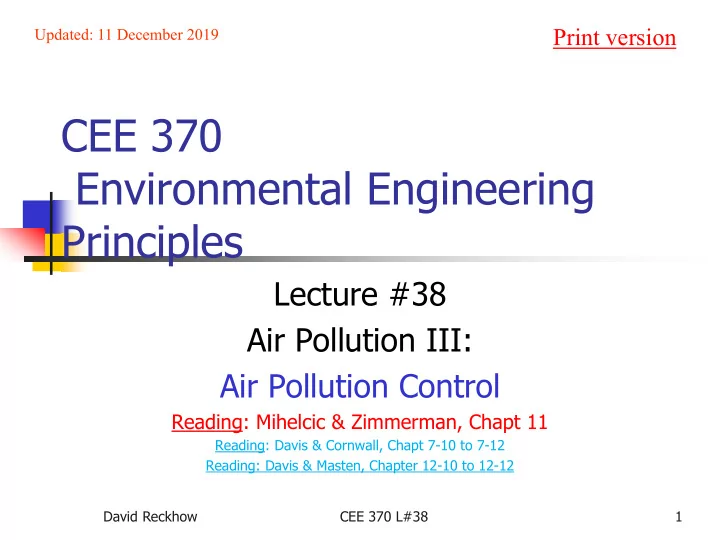

Print version Updated: 11 December 2019 CEE 370 Environmental Engineering Principles Lecture #38 Air Pollution III: Air Pollution Control Reading: Mihelcic & Zimmerman, Chapt 11 Reading: Davis & Cornwall, Chapt 7-10 to 7-12 Reading: Davis & Masten, Chapter 12-10 to 12-12 David Reckhow CEE 370 L#38 1
Gasoline Combustion Engine Effect of air-to-fuel ratio on emissions, power, and fuel economy 2 CEE 370 L#38 David Reckhow
Catalytic Converter 3 CEE 370 L#38 David Reckhow
Clean air Acid control: wet scrubbing out Water or Caustic Caustic Spray Spray Contaminated Air in Demister See: Figure Sludge 11.18 in M&Z out 4 CEE 370 L#38 David Reckhow
Example Estimate the amount of calcium oxide required per 1000 ft 3 of exhaust gas to neutralize 2000 ppm of sulfur dioxide at 20 o C. = CV M SO 2 3 3 3 10 m air x Mole SO m SO 22.4 L SO x 10 L SO m air 2 2 2 = 2000 x M SO 6 3 3 3 2 m SO 35.3 ft air 2 2 = 2.53 Mole SO 2 M SO 3 3 2 10 ft air H SO + CaO = CaSO + H O 2 3 3 2 1mole 1mole 5 CEE 370 L#38 David Reckhow
Example (cont.) = 2.53 Mole SO 10 ft air x 1 Mole CaO 1 Mole SO x 56 g CaO 2 M CaO 3 3 1 Mole CaO 2 g CaO lbs CaO = 142 10 ft air = 0.312 M CaO 3 3 3 3 10 ft air 6 CEE 370 L#38 David Reckhow
Particulate Control: Cyclones Clean air Contaminated Especially air effective for particle sizes greater than 10 µ m. Centrifugal force cause particles to impact cyclone wall and slide to the bottom of the cone. See: Figure 11.18 in M&Z Dust 7 CEE 370 L#38 David Reckhow
Other Particulate Control Processes Baghouse Filters M&Z: Figure 11.18; Ray: Figure 13.8, Masters: Fig. 7.33, M&D: Figure 12-28 heat-resistant porous fabric cleaned by vibration Electrostatic Precipitators (ESP) M&Z: Figure 11.18; Masters: Fig. 7.32, M&D: Fig 12-30 &31 use high voltage electric field; particles are ionized (by negative plate) and collected on the positive plate 8 CEE 370 L#38 David Reckhow
Electrostatic Precipitator Dry collection of particles Large potential between plates Particles are give a negative charge Then trapped on the positive plate See: Figure 11.18 in M&Z 9 CEE 370 L#38 David Reckhow
Baghouse Composition Natural or synthetic fibers Bag life 1-5 years See: Figure 11.18 in M&Z 10 CEE 370 L#38 David Reckhow
To next lecture 11 CEE 370 L#38 David Reckhow
Recommend
More recommend